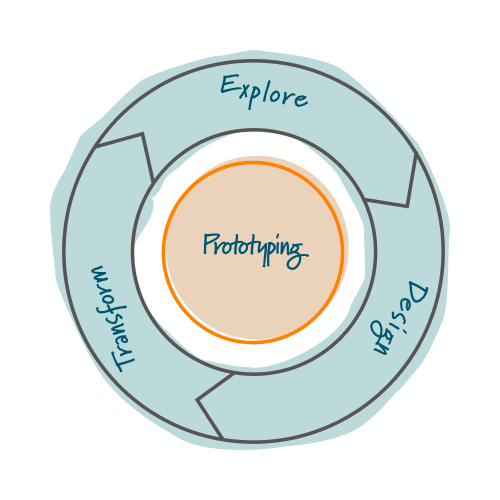
The Transformation to an Agile Product Mentality
Agile product development – The transformation to an agile product mentality

Burcu Bayram
Sunday, December 1, 2024
In a constantly changing business world, where customer needs are in a state of flux, agile product development is becoming a decisive factor for success. Many companies are increasingly striving to move away from a rigid, project-based structure and instead establish a flexible and customer-oriented mindset. However, they often fail to achieve the expected benefits. Why is that?
Being agile does not mean working without a plan and changing your mind whenever you feel like it. Being agile means focusing on creating value for customers. It means focusing on the product, not on projects, their results or output.
Agile product development aims to shift the focus from isolated projects to continuous value creation for the customer. It is not just about bringing products to market faster, but rather about developing products that meet the needs and expectations of customers and offer sustainable added value.
This transformation requires more than just structural adjustments – it requires a fundamental mindset change.
A key component to the success of agile product development is creating an agile mindset within the organisation. This requires an open mindset that welcomes change and views uncertainty as an opportunity. It also requires a strong customer focus and a willingness to continuously adapt to evolving customer needs.
The critical role of mindset change
A study conducted by McKinsey (2020) highlights the importance of developing an agile mindset. 60% of the participants stated that they are currently undergoing a transformation to become an agile organisation, with the main challenge for these companies being to change their culture – or, in other words, the mindset of the people involved.

Mindset plays a central role in the implementation of agile practices. However, this mindset is often challenged by obstacles such as a lack of willingness to change and a command-and-control culture, which can negatively impact the work environment. Silo mentalities, resistance to change, fear of failure and a lack of collaboration are just some of the obstacles that companies can encounter on their journey to becoming more agile. Overcoming these obstacles is crucial to ensuring a successful agile transformation.
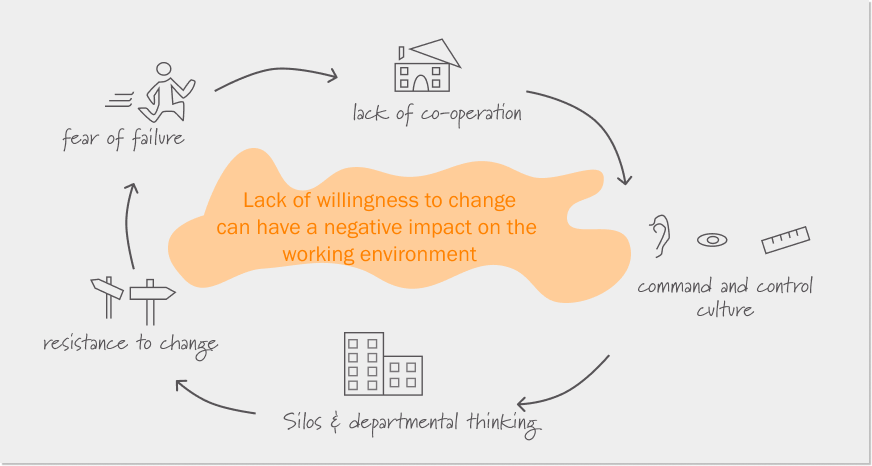
From linear to iterative processes
In companies, two different approaches can be identified when it comes to product development: the waterfall approach (top figure) and the agile approach (bottom figure).
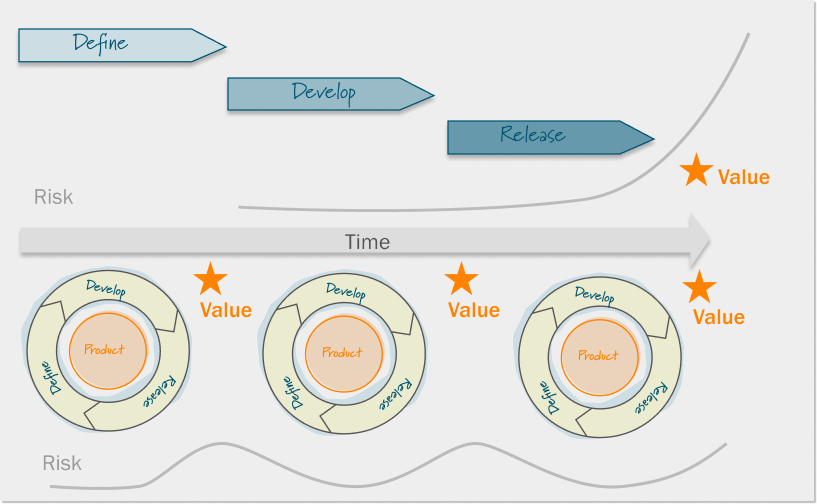
The waterfall approach follows a sequential process in which planning and execution are determined in advance. Delivery cycles are long and there is limited customer involvement during the development process.
In contrast, the agile approach emphasises iterative and incremental development, continuous customer integration and short development cycles. By focusing on individual interaction and flexibility, it enables early value creation and adaptability throughout the entire development process.
The choice between these two approaches has a direct impact on business practice and entails both opportunities and risks:
Value Creation
The agile approach enables continuous value creation through early interaction and continuous feedback. This allows products to be adapted more quickly to customer needs and ultimately made more competitive.
In contrast, with the waterfall approach, value is often only created at the end of the development process, which can lead to longer time-to-market and a higher risk that the end product will not meet customer expectations.
Risks
Being agile means continuously adapting and remaining flexible. While the agile approach offers the opportunity to react quickly to changing market requirements, there is also a risk that the project goal will shift during the development process or that the teams will have difficulty focusing on short-term goals.
With the waterfall approach, there is a risk that changes made late in the development process will be expensive and difficult to implement because the project is already well advanced and changes are difficult to reverse.
Concrete examples can be used to illustrate how these two approaches affect business practice:
Many managers who come from a hierarchical structure follow the already mentioned command and
control scheme. Instead of leading and trusting their teams, managers tend to direct and control their teams according to their individual goals or the goals of their departments, which were usually defined from above. This is more of a waterfall approach, with an emphasis on planning and control.
But what happens when this silo mentality dominates the agenda of all employees and decisions are based on the favour of individual departments, rather than on corporate goals or customer interests?
As a result, actions are not aligned with the overarching idea of creating value for the customer. This reveals a lack of agile practice that makes it difficult to ensure customer satisfaction and long-term business success.
Key aspects of agile product development
There are three aspects we consider crucial when entering the world of agile product development: customer centricity, minimum viable product (MVP) thinking, and the concept of empowered teams.
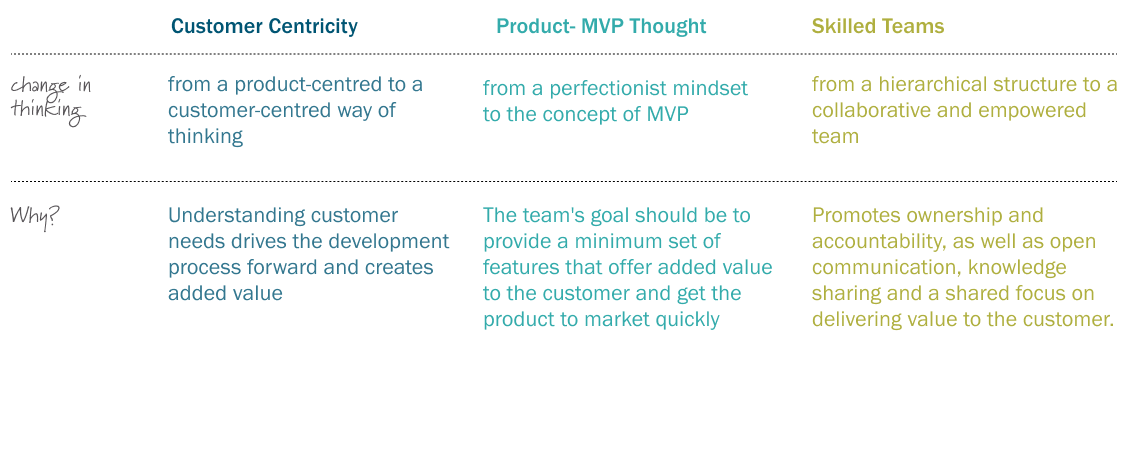
Customer centricity
Let's take a closer look at the area of customer centricity. Let's start with a fundamental thought: a company exists to acquire customers and retain them over the long term. This perspective emphasises that designing and delivering products and services should not be done in isolation from the needs and expectations of customers.
Customer centricity therefore means not only developing products that meet the company's expectations, but rather understanding and shaping the customer journey. This requires a deep understanding of the interactions, emotions and needs of the customer along their entire journey with the product or service.
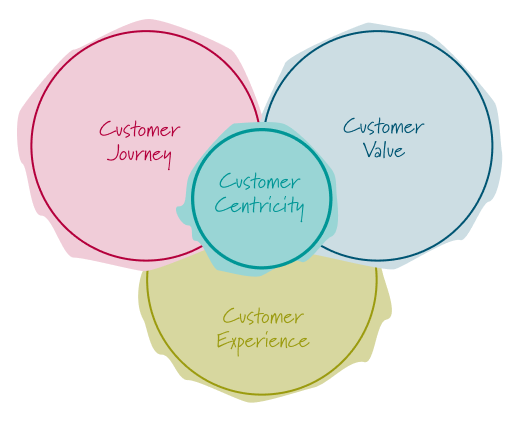
The customer experience encompasses the totality of interactions and satisfaction that a customer experiences during their interaction with a product or service. In agile product development, the customer experience is optimised through an iterative and collaborative approach that allows for quick responses to changing customer needs and demands.
Another important aspect is the customer benefit that arises from the advantages and positive experiences offered by the product or service. It is crucial that this benefit outweighs the costs incurred by the customer.
The Agile Manifesto emphasises the importance of customer collaboration over contract negotiations. This emphasis on collaboration between customers and the development team reflects the value that agile organisations place on continuous interaction and feedback from customers.
Customer centricity offers companies the opportunity to create long-term competitive advantage by accurately understanding and meeting the needs and expectations of their customers. However, they face challenges such as balancing customer needs and internal business objectives, as well as budget constraints and potential resistance from management.
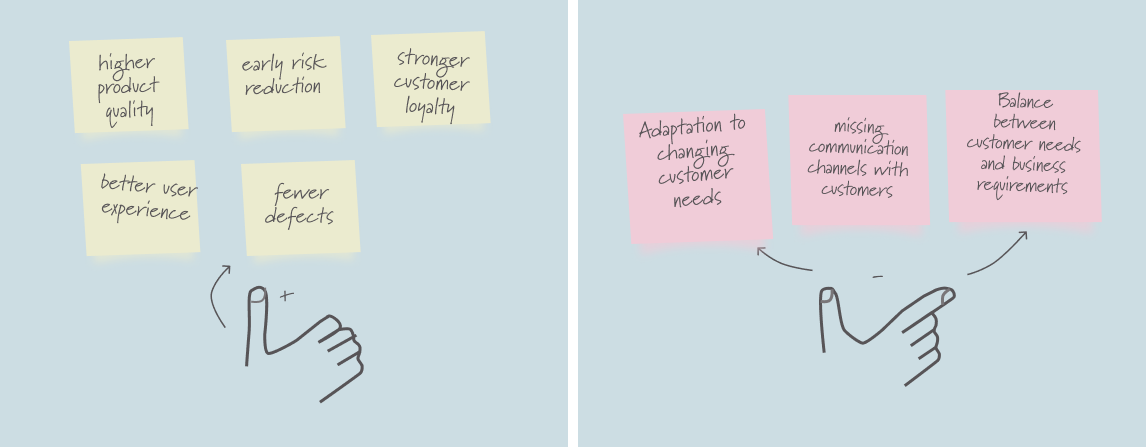
A practical example illustrates these aspects: A software company decides to develop a new feature for its application. By continuously working with customers and gathering feedback throughout the development process, the company can ensure that the new feature meets the customers' needs exactly and offers real added value. This leads to increased customer satisfaction and loyalty.
MVP thinking
‘Don't spend time perfecting a product before you've validated that people actually want it.’ This statement highlights the importance of a minimum viable product (MVP) as opposed to a perfectly engineered product. An MVP contains only the most necessary features to meet the needs of the first customers and gather valuable feedback for further development.
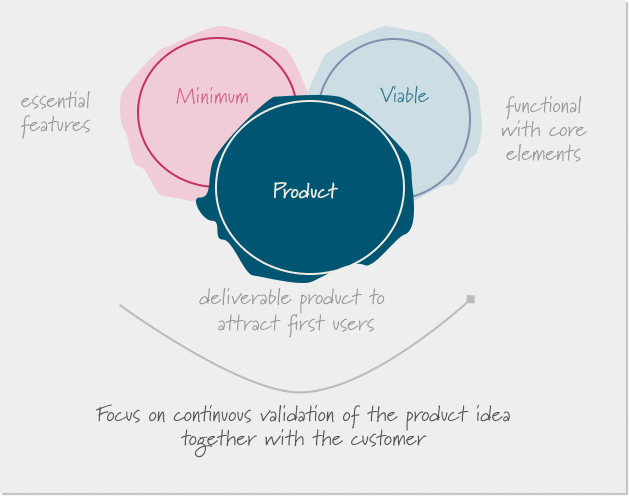
The Agile Manifesto also emphasises the importance of an early MVP here by putting working software above comprehensive documentation. This implies that it is more beneficial to have a working version of a product early on than to release a perfect product much later.
However, defining an MVP can be challenging because it is often difficult to agree on what a minimal set of features is to verify customer needs and desires. There are various methods for doing this, one of which is the WSJF method (Weighted Shortest Job First). This can be used to identify those jobs that promise the fastest value generation. A job is representative of a feature, an epic, a capability or similar package sizes that have been defined in the respective company context. For each job, the WSJF is calculated from the costs of delay and the job size (time required) (WSJF = costs of delay/job size). The higher the WSJF value, the higher the job is prioritised.
The costs of delay are an approximation of the expected value:
- User and business value: How does the customer benefit (user value), how does the company benefit (business value)?
- Time criticality:Does completion in a few months have the same value as it does today?
- Risk reduction and/or opportunity enablement: Are there risks that we can reduce by implementing the job? Are we building new skills or technical capabilities with the implementation that will benefit other projects?

In other words, the ‘costs of delay’ are positively influenced by the direct added value for customers and companies and additional constraints that make it sensible to start the implementation now rather than tomorrow.
In addition to the WSJF method, an impact-deployment matrix can be helpful when prioritising features. This matrix categorises features into four quadrants:
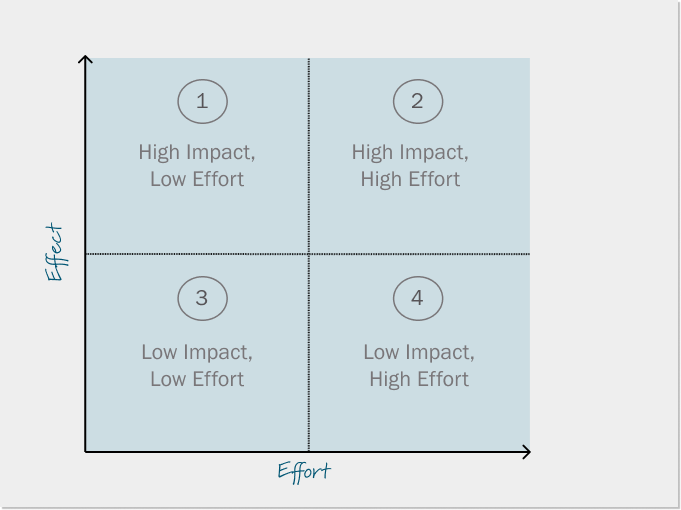
1. High impact, low effort: These features should be prioritised because they provide great benefit with minimal effort.
2. High impact, high effort: These features are also important, but due to the high effort involved, it should be carefully considered when and how they are implemented.
3. Low impact, low effort: These features can be implemented when the opportunity arises because they are easy to implement but have little impact.
4. Low impact, high effort: These features should be avoided or at least tackled very late because they require a lot of effort for little benefit.
By using these methods, teams can strategically decide which features should be implemented first to achieve the greatest possible benefit with minimal effort.
Let's say you've reached out to your customers, analysed the market or conducted surveys to find out what your customers want. Based on the prioritised features, an MVP has been developed; the next step can now be to thoroughly analyse the collected data and make informed product decisions for the upcoming iterations based on this.
An example of a helpful tool in user analysis is the ‘System Usability Scale’ (SUS). The SUS provides a quick and easy, yet reliable method for measuring usability. It consists of a 10-point questionnaire with five response options for respondents and allows you to assess the usability of a variety of products and services, including hardware, software, mobile devices and websites.
It is therefore important not only to interact with your customers, but also to use the data obtained from these feedback loops and integrate it into your agile development process. This is the key to successful product design.
Let's now look at the advantages of MVPs. An MVP enables early customer involvement, which leads to a quick time to market. The flexibility and adaptability allow the product to be continuously improved to meet market needs. This ultimately increases market value and reduces the risk of failure.
However, there are also challenges in implementing MVPs. These include handling customer requirements and expectations of a product that has not yet been fully developed. Limited resources and technical complexity can also complicate implementation. Furthermore, the urge for perfection can hinder the rapid and iterative development process.
By making data-driven decisions and applying the principles of an MVP, you can develop a product that meets the real needs of your customers while remaining flexible and adaptable.
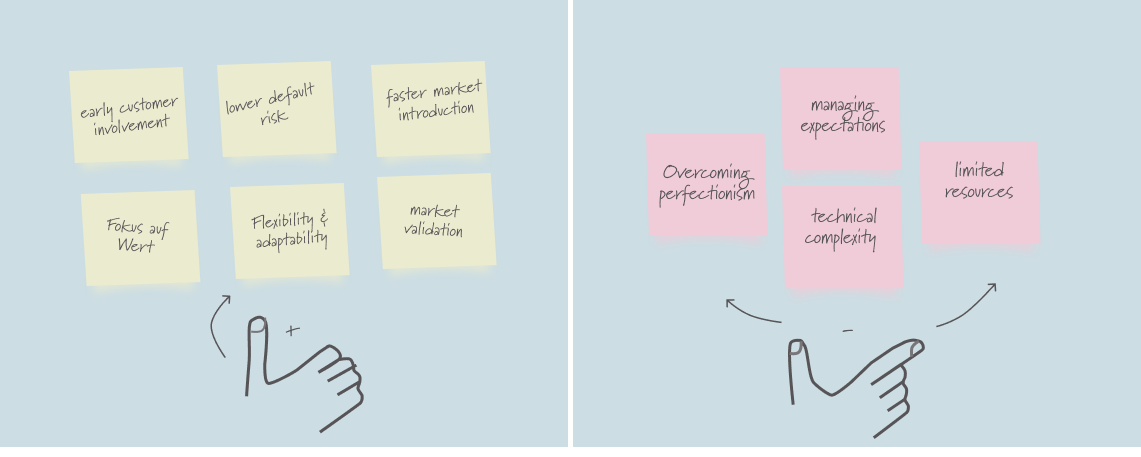
Empowered Teams
Let's take a look at the structure that many organisations have before they decide to adopt agile product development. These are often characterised by functional specialisation and management hierarchy, which often lead to the formation of silos. These silos imply that teams work in isolation from each other, without effective communication and collaboration. These teams are often managed top-down, which means that they are given clear goals and prescribed how to achieve them by defining processes and measures. This is an attempt to establish control in a very complex world and takes away the opportunity for teams to develop creative and efficient working methods together in order to adapt to the constantly changing requirements in this complex world. This results in a lack of information sharing and understanding of other teams' activities, which limits flexibility and adaptability in overcoming challenges.
Empowered Teams, on the other hand, are like living organisms that continuously.
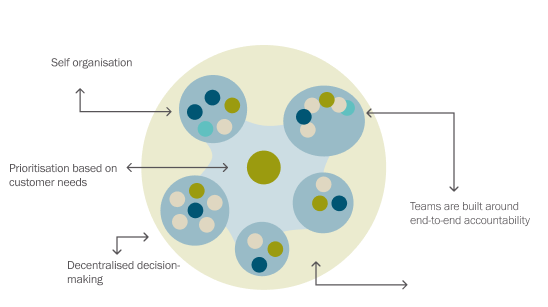
They are characterised by several key features:
Autonomy: Empowered Teams have the authority to make decisions at the operational level without consulting or obtaining approval from senior management. This autonomy fosters a sense of responsibility and motivation within the team.
Ownership: Team members take responsibility for their tasks and decisions. This ownership enables teams to respond flexibly to change and act efficiently.
Self-organisation: Empowered teams organise themselves independently to achieve their goals. They can adapt workflows and optimise processes to be more efficient.
Continuous improvement: Empowered teams strive to constantly improve. They use feedback and continuously reflect on their working methods to become more effective and develop further.
In Scrum, for example, clear roles and responsibilities are defined, but the teams have the freedom to adapt and improve their working methods. The Agile Manifesto is at the forefront of this, emphasising that individuals and interactions are more important than processes and tools.
The what is predetermined and they can decide for themselves how they want to work.
Scrum also defines various meeting formats, such as dailies, sprint planning, reviews and retrospectives, which ensure a regular exchange of information and thus promote effective collaboration.
When implemented correctly, empowered teams take on continuous responsibility, enabling faster decision-making and more flexible responses to challenges. By directly involving them in the decision-making process and enabling them to respond quickly to customer feedback, they can develop products and services that better meet customer needs. The challenges of working with empowered teams often lie in establishing a supportive corporate culture that promotes personal responsibility and self-organisation, while at the same time ensuring clear communication channels and decision-making processes.
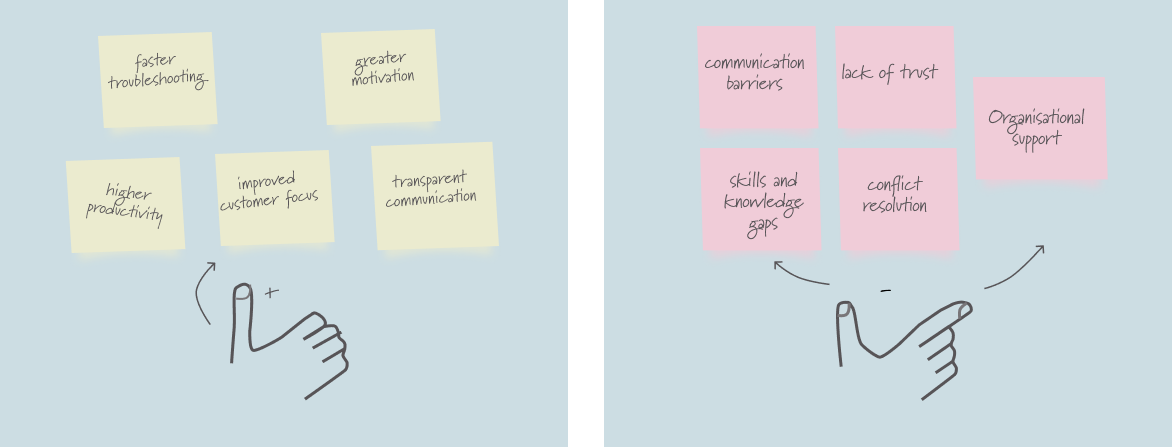
System dynamics
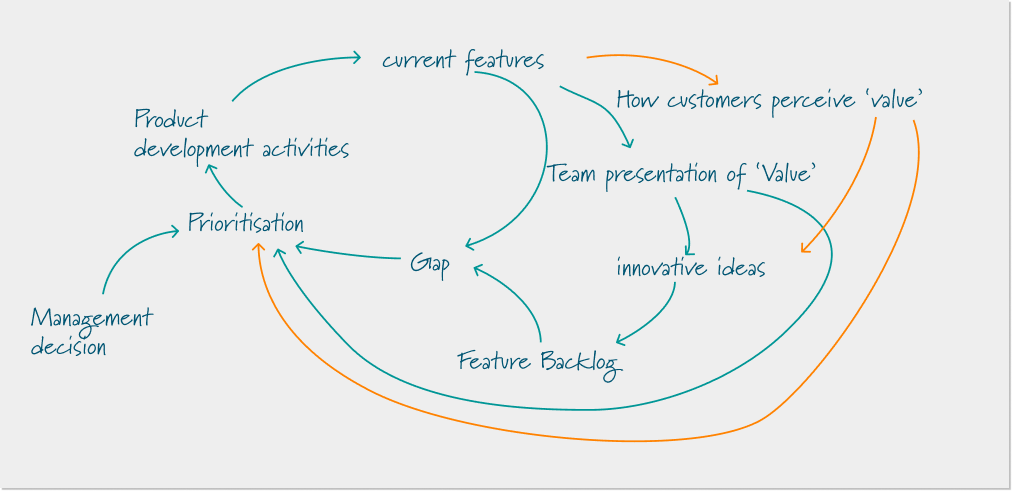
Let's look at the connection between different elements in our agile product development system and see how empowered teams, customer centricity and MVP thinking are linked
Let's start with the current product features that the team assumes are already in the product. Based on the perception of the value of these features, the team develops ideas for the next iteration and creates a feature backlog. Without customer feedback, the team prioritises based on their perception alone and continues the product development cycle.
However, when customer perception of value is incorporated by asking customers for their opinion on the current features, the team integrates this feedback into the innovation process and prioritises the feature backlog accordingly. This integration of customer perception enables better prioritisation and a deeper understanding of customer needs.
This interaction between team and customer perception influences the time-to-market loop because a faster process for defining and prioritising features integrates feedback more quickly into the development cycle. In addition, the empowered teams are crucial because they have the autonomy to develop ideas and make decisions to prioritise the backlog.
As an outer loop and central element, customer centricity acts on the entire agile product development system. Integrating customer feedback and aligning with customer needs enables companies to deliver products that better meet market demands and provide long-term competitive advantage.

Excursus: Retrospective on agile product development
During one of our regularly scheduled meetups on the topic of ‘Agile Product Development’, the focus was not only on theory, but also on the practical exchange of experiences with our participants. In an interactive retrospective, we discussed the evening's key topics together: customer centricity, MVP thinking and empowered teams. Valuable experiences and insights were shared on how these concepts can be applied in different organisations and what challenges arise in the process.
These open discussions allowed us to learn not only from success stories, but also from the obstacles that can arise on the road to agile product development. From these, we derived concrete measures that we have identified as best practices for the successful implementation of agile product development.

Derived measures:
Customer focus
Obtain feedback: Continuously obtain feedback from customers and users to better understand their needs and expectations.
Iterative work (also through prototyping): By creating prototypes and quick iterations, products can be tested and improved at an early stage.
Design thinking: Apply design thinking methods to develop innovative solutions that address customer needs.
Thoughtful communication: Clear and effective communication within the team and with customers to avoid misunderstandings and promote a shared vision.
UX/CX: Extensive research into user experience (UX) and customer experience (CX) to develop a deep understanding of the needs and behaviours of the target group.
MVP thinking
Get external feedback: Involve external stakeholders and customers to get early feedback and steer development in the right direction.
Focus on core features: Concentrate on developing the core features of the product to quickly deliver a minimum viable product (MVP).
Feature team vs. component teams: Organisational focus on functional teams that work on the development of complete features, instead of isolated components.
Empowered teams
Transparency: Open and transparent communication within the team and with all stakeholders to build trust and promote a common understanding.
Clear guidelines: Setting clear (team) goals, expectations and responsibilities to support the autonomy of the teams and ensure alignment on common objectives.
Frequent and transparent communication at all levels: Regular updates and exchanges at all levels of the organisation to create a shared understanding of progress and challenges.
Building skills in the team: Developing the skills and competencies of team members through training, mentoring and mutual learning.
Trust and communication: Fostering an environment of trust and openness in which team members feel safe to share ideas and take risks.
The feedback and discussions of the participants helped us not only to learn from each other, but also to get new impulses for future meetups. We look forward to incorporating these insights into our future events and continuing to promote an open exchange.

Table of Contents
Newsletter
Stay up to date about content and events.
Upcoming EventsEvents overview
Upcoming Events
Events overview
ENTERPRISE ARCHITECTUREPSFSYSTEM DYNAMICSDIGITAL TRANSFORMATIONBUSINESS MODELBUSINESS TRANSFORMATIONBeer Distribution GameADVANCED ANALYTICSSIMULATIONBUSINESS PROTOTYPING
Services
Workshops
Resources
All Rights Reserved.

